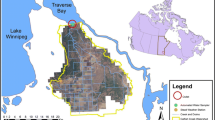Abstract
Between 2000 and 2006, the New Hampshire Department of Environmental Services and the University of New Hampshire collected water quality samples at 25 to 40 stations per year in a 56.5-km2 estuary as part of the Environmental Protection Agency’s National Coastal Assessment program. Due to the high density of stations, probabilistic statistics for the estuary could be calculated with low uncertainty. The proportions of the estuary exceeding thresholds in each year were calculated for temperature, salinity, dissolved oxygen, chlorophyll a, nitrogen as nitrate and nitrite, nitrogen as ammonium, phosphorus as orthophosphate, total suspended solids, and fecal coliform bacteria. These values were tested for trends over time and correlations with climate variables. The same statistical tests were applied to monthly grab sample data from a representative station in the estuary. The outcomes of the statistical tests on the two datasets were compared to determine if they provided similar information to coastal managers. Trends and correlations were equally likely to be detected using the probability-based data and the fixed station data, but the results were different for the two datasets. The differences were likely due to the distributed nature of the probability-based sampling design, which places stations in all sections of the estuary. In addition, expressing the probabilistic datasets as estimated proportions reduced variability in volatile parameters, such as bacteria, relative to the grab sample dataset. It will be important to develop tools to rectify trends from probability-based surveys with fixed station monitoring to provide clear information to managers.
Similar content being viewed by others
References
APHA (1989). Standard methods for the examination of water and wastewater (17th ed.). Washington DC: American Public Health Association.
Comstock, G. (2004). 2004 Section 305(b) and 303(d) surface water quality report, NHDES-R-WD-04-6. Concord, NH: N.H. Department of Environmental Services, Watershed Management Bureau.
Diaz-Ramos, S., Stephens, D. L., & Olson, T. A. (1996). EMAP statistical methods manual. Retrieved February 6, 2008, from the U.S. Environmental Protection Agency web site: http://www.epa.gov/nheerl/arm/documents/intro.pdf.
EPA (2001). National coastal condition report, EPA/620/R-01/005. Retrieved February 6, 2008, from the U.S. Environmental Protection Agency web site: http://www.epa.gov/owow/oceans/nccr/.
EPA (2004). National coastal condition report II, EPA/020/R-03/002. Retrieved February 6, 2008, from the U.S. Environmental Protection Agency web site: http://www.epa.gov/owow/oceans/nccr/.
EPA (2006). Data quality assessment: statistical methods for practitioners, EPA QA/G-9S, EPA/240/B-06/003. Retrieved February 6, 2008, from the U.S. Environmental Protection Agency web site: http://www.epa.gov/quality/qa_docs.html.
EPA (2007). National coastal condition report III. Washington, DC: U.S. Environmental Protection Agency, Office of Research and Development and Office of Water.
Gilbert, R. O. (1987). Statistical methods for environmental pollution monitoring. New York: Van Nostrand Reinhold.
Heitmuller, T. (2001). National coastal assessment quality assurance project plan 2001–2004, EPA/620/R-01/002. Retrieved February 6, 2008, from the U.S. Environmental Protection Agency web site: http://www.epa.gov/emap/nca/html/docs/qaprojplan.html.
NHEP (2006). State of the estuaries 2006. Retrieved February 6, 2008, from the New Hampshire Estuaries Project web site: http://www.nhep.unh.edu/resources/pdf/2006_state_of_the-nhep-06.pdf.
NHEP (2007). Hydrologic parameters for New Hampshire’s estuaries. Retrieved February 6, 2008, from the New Hampshire Estuaries Project web site: http://www.nhep.unh.edu/resources/pdf/hydrologic_parameters_for-nhep-07.pdf.
Strobel, C. J. (2004). Coastal 2000, northeast component, field operations manual, EPA/620/R-00/002. Retrieved February 6, 2008, from the U.S. Environmental Protection Agency web site: http://www.epa.gov/emap/nca/html/docs/c2knefm.html.
Triola, M. R. (1998). Elementary statistics (17th ed.). Reading, MA: Addison-Wesley.
Author information
Authors and Affiliations
Corresponding author
Rights and permissions
About this article
Cite this article
Trowbridge, P.R., Jones, S.H. Detecting water quality patterns in New Hampshire’s estuaries using National Coastal Assessment probability-based survey data. Environ Monit Assess 150, 129–142 (2009). https://doi.org/10.1007/s10661-008-0683-x
Received:
Accepted:
Published:
Issue Date:
DOI: https://doi.org/10.1007/s10661-008-0683-x




